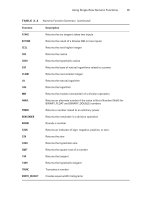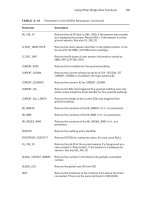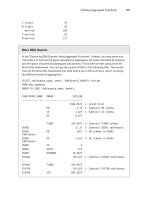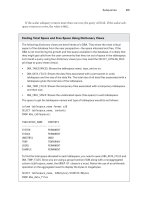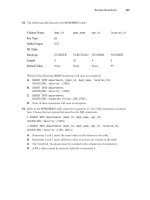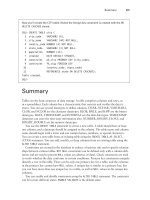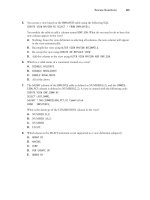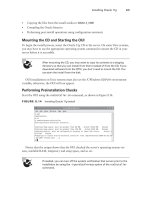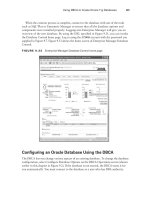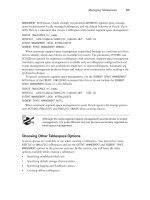Tài liệu Pro Oracle Database 11g RAC on Linux docx
Bạn đang xem bản rút gọn của tài liệu. Xem và tải ngay bản đầy đủ của tài liệu tại đây (14.34 MB, 830 trang )
Books for professionals By professionals
®
US $59.99
Shelve in:
Databases / Oracle
User level:
Intermediate–Advanced
THE APRESS ROADMAP
Pro
Oracle Database 11g
Administration
Pro
Oracle SQL
Beginning
Oracle Database 11g
Administration
Beginning
Oracle SQL
Pro
Oracle Database 11g
RAC on Linux
Expert
Oracle Practices
www.apress.com
SOURCE CODE ONLINE
Companion eBook
Steve Shaw, Author of
Pro Oracle Database 10g
RAC on Linux
Martin Bach
Pro Oracle Database 11g RAC
on Linux
Dear Reader,
You are holding in your hands the result of our experience and best-thinking when
it comes to installing, configuring, and tuning Oracle Database 11g RAC on Linux.
Real Application Clusters, or RAC as it is commonly called, is Oracle’s industry-
leading architecture for building scalable and fault-tolerant databases. RAC pro-
vides redundancy through multiple servers, allowing you to scale up and down
simply by adding or subtracting servers.
Using practical examples and illustrations we take you through all the stages
of building the infrastructure for the latest 11g Release 2 clustered environments
from selecting the right hardware components to installing and configuring Oracle
Enterprise Linux. We detail how to install and configure Oracle VM—Oracle’s
own virtualization solution—to enable anyone to begin working with Oracle RAC
straight away. We show the spectrum of configurations from single server to a fully
virtualized RAC implementation.
Building upon the Linux foundation, you will see how to successfully imple-
ment Oracle’s Grid infrastructure and RAC database software even when upgrad-
ing from an Oracle Database 10g release. You will also learn how to manage and
monitor your new clustered installation through workload management and per-
formance monitoring, and parallel execution.
We make no assumptions on your experience with Oracle 11g RAC Release 2,
or with Linux. Our goal in this book is to provide a complete reference to all of the
information you will need, beginning with the essential grounding of concepts and
architecture. We have comprehensively researched, tested, and detailed every step
of the process so this book can be your guide to taking the next step in the evolu-
tion of grid and cloud computing with Oracle 11g Release 2 RAC on Linux.
Steve Shaw & Martin Bach
The eXperT’s Voice
®
in oracle
Pro
Oracle Database 11g
RAC on Linux
Installation, Administration, Performance
Steve Shaw and Martin Bach
Create robust and scalable database systems
using Oracle’s clustering and grid technologies
Covers
11g Release 2
Shaw
Bach
Oracle Database 11g RAC on Linux
Companion
eBook Available
Pro
www.it-ebooks.info
www.it-ebooks.info
Pro Oracle Database 11g RAC
on Linux
Steve Shaw
Martin Bach
www.it-ebooks.info
Pro Oracle Database 11g RAC on Linux
Copyright © 2010 by Steve Shaw and Martin Bach
All rights reserved. No part of this work may be reproduced or transmitted in any form or by any means,
electronic or mechanical, including photocopying, recording, or by any information storage or retrieval
system, without the prior written permission of the copyright owner and the publisher.
ISBN-13 (pbk): 978-1-4302-2958-2
ISBN-13 (electronic): 978-1-4302-2959-9
Printed and bound in the United States of America 9 8 7 6 5 4 3 2 1
Trademarked names, logos, and images may appear in this book. Rather than use a trademark symbol
with every occurrence of a trademarked name, logo, or image we use the names, logos, and images only
in an editorial fashion and to the benefit of the trademark owner, with no intention of infringement of
the trademark.
The use in this publication of trade names, trademarks, service marks, and similar terms, even if they are
not identified as such, is not to be taken as an expression of opinion as to whether or not they are subject
to proprietary rights.
President and Publisher: Paul Manning
Lead Editor: Jonathan Gennick
Technical Reviewer: Bernhard Cock Buning and Sandesh Rao
Editorial Board: Clay Andres, Steve Anglin, Mark Beckner, Ewan Buckingham, Gary Cornell,
Jonathan Gennick, Jonathan Hassell, Michelle Lowman, Matthew Moodie, Duncan Parkes,
Jeffrey Pepper, Frank Pohlmann, Douglas Pundick, Ben Renow-Clarke, Dominic Shakeshaft,
Matt Wade, Tom Welsh
Coordinating Editor: Anita Castro
Copy Editor: Patrick Meader and Mary Ann Fugate
Compositor: Bytheway Publishing Services
Indexer: BIM Indexing & Proofreading Services
Artist: April Milne
Cover Designer: Anna Ishchenko
Distributed to the book trade worldwide by Springer Science+Business Media, LLC., 233 Spring Street,
6th Floor, New York, NY 10013. Phone 1-800-SPRINGER, fax (201) 348-4505, e-mail orders-ny@springer-
sbm.com, or visit www.springeronline.com.
For information on translations, please e-mail , or visit www.apress.com.
Apress and friends of ED books may be purchased in bulk for academic, corporate, or promotional use.
eBook versions and licenses are also available for most titles. For more information, reference our
Special Bulk Sales–eBook Licensing web page at www.apress.com/info/bulksales.
The information in this book is distributed on an “as is” basis, without warranty. Although every
precaution has been taken in the preparation of this work, neither the author(s) nor Apress shall have
any liability to any person or entity with respect to any loss or damage caused or alleged to be caused
directly or indirectly by the information contained in this work.
www.it-ebooks.info
CONTENTS AT A GLANCE
iii
Contents at a Glance
About the Author xxi
About the Technical Reviewer xxii
Acknowledgments xxiii
Chapter 1: Introduction 1
Chapter 2: RAC Concepts 27
Chapter 3: RAC Architecture 63
Chapter 4: Hardware 97
Chapter 5: Virtualization 165
Chapter 6: Linux Installation and Configuration 231
Chapter 7: Grid Infrastructure Installation 323
Chapter 8: Clusterware 379
Chapter 9: Automatic Storage Management 455
Chapter 10: RDBMS Installation and Configuration 505
Chapter 11: Workload Management 559
Chapter 12: Oracle Performance Monitoring 607
Chapter 13: Linux Performance Monitoring 653
Chapter 14: Parallel Execution 687
Chapter 15: Upgrading to Oracle 11g Release 2 717
Index 771
www.it-ebooks.info
CONTENTS
iv
Contents
About the Authors xxi
About the Technical Reviewers xxii
Acknowledgments xxiii
Chapter 1: Introduction 1
Introducing Oracle Real Application Clusters 1
Examining the RAC Architecture 3
Deploying RAC 4
Maintaining High Availability 5
Defining Scalability 6
Scaling Vertically vs. Horizontally 7
Increasing Manageability 8
Assessing the Cost of Ownership 10
Clustering with Oracle on Linux 13
Running Linux on Oracle 16
Understanding the Role of Unix 16
Liberating Software 17
Developing Linux 18
Expanding the Concept of Free with Open Source 19
Combining Oracle, Open Source, and Linux 20
Drilling Down on Unbreakable Linux 21
Creating and Growing Red Hat Enterprise Linux 22
Extending Red Hat with Oracle Enterprise Linux 23
Drilling Down on SuSE Linux Enterprise Server 24
www.it-ebooks.info
CONTENTS
v
Taking Linux to Asia 25
Summary 25
Chapter 2: RAC Concepts 27
Clustering Concepts 27
Configuring Active/active Clusters 27
Implementing Active/passive Clusters 28
Configuring a Shared-All Architecture 28
Configuring a Shared-Nothing Architecture 29
Exploring the Main RAC Concepts 29
Working with Cluster Nodes 29
Leveraging the Interconnect 30
Clusterware/Grid Infrastructure 31
Leveraging Automatic Storage Management 39
Installing Real Application Clusters 44
Using the Global Resource Directory (GRD) 49
Transferring Data Between Instances with Cache Fusion 51
Achieving Read Consistency 52
Synchronizing System Change Numbers 52
Exploring the New Features of 11g Release 2 52
Leveraging Grid Plug and Play 53
Modeling Resources with Server Pools 55
Ensuring POSIX Compliance with ACFS 56
Using Oracle Restart Instead of RAC 57
Simplifying Clusterd Database Access with SCAN Listener 59
Summary 60
Chapter 3: RAC Architecture 63
Availability Considerations 63
Deciding the Number of Nodes 65
www.it-ebooks.info
CONTENTS
vi
Online Maintenance and Patching 67
Instance Recovery in RAC 72
Failover Considerations 74
Transparent Application Failover 75
Fast Connection Failover and Fast Application Notification 76
Scalability Considerations 77
Scalability Enhancers 78
Scalability Inhibitors 79
Standby Databases 81
Introduction to Oracle Standby Databases 82
Types of Standby Database 83
Active Data Guard 85
Extended Distance Clusters 90
Oracle Streams 91
Streams Processing 92
Oracle Streams Prerequisites 93
Cluster Topologies 94
Summary 95
Chapter 4: Hardware 97
Oracle Availability 98
Server Processor Architecture 99
x86 Processor Fundamentals 99
Multicore Processors and Hyper-Threading 103
CPU Cache 106
CPU Power Management 109
Virtualization 111
Memory 112
Virtual Memory 112
www.it-ebooks.info
CONTENTS
vii
Physical Memory 113
NUMA 116
Memory Reliability 125
Additional Platform Features 125
Onboard RAID Storage 126
Machine Check Architectures 126
Remote Server Management and IPMI 127
Network Interconnect Technologies 127
Server I/O 128
Private Interconnect 131
Storage Technologies 136
RAC I/O Characteristics 137
Hard Disk and Solid State Disk Drive Performance 143
RAID 147
Storage Protocols for Linux 153
Summary 164
Chapter 5: Virtualization 165
Virtualization Definition and Benefits 165
Oracle VM 168
Oracle VM Server Architecture 168
Oracle VM Design 174
Oracle VM Server Installation 178
Oracle VM Manager Installation 183
Oracle VM CLI Installation and Configuration 186
Configuring Oracle VM 187
Network Configuration 187
Server Pool Configuration 192
Installing and Configuring Guests 208
www.it-ebooks.info
CONTENTS
viii
Importing a Template 209
Creating a Guest from a Template 210
Accessing a Guest 212
Configuring a Guest for RAC 214
Managing Domains 216
Oracle VM Agent 216
Oracle VM Manager 218
Oracle VM Manager CLI 220
The xm Command-Line Interface 222
Summary 230
Chapter 6: Linux Installation and Configuration 231
Selecting the Right Linux Software 231
Reviewing the Hardware Requirements 232
Drilling Down on Networking Requirements 233
Configuring a GNS or a Manual IP 233
Configuring DNS and DHCP 236
Downloading the Linux Software 243
Preparing for a Network Install 243
Installing Oracle Enterprise Linux 5 247
Starting the Installation 247
Installation Media Check 247
Anaconda Installation 247
Install or Upgrade 248
Disk Partitioning 248
Configuring the Boot Loader and Network 259
Selecting a Time Zone 260
Configuring the Root Password 261
Reviewing the Package Installation Defaults 261
www.it-ebooks.info
CONTENTS
ix
Selecting a Package Group 261
Installing Packages 263
Setting the Final Configuration 263
Accepting the License Agreement 263
Configuring the Firewall 263
Configuring SELinux 263
Enabling kdump 264
Setting the Date and Time 264
Creating a User 265
Installing Additional CDs 265
Configuring Oracle Enterprise Linux 5 265
Configuring a Server with the Oracle Validated RPM 266
Verifying the Oracle Validated RPM Actions 270
Post Oracle Validated RPM Configuration 282
Completing the Linux Configuration for RAC 292
Configuring Shared Storage 298
Discovering and Configuring SAN Disk 299
Network Channel Bonding 313
I/O Fencing with IPMI 317
Summary 322
Chapter 7: Grid Infrastructure Installation 323
Getting Ready for Installation 323
Obtain Software Distribution 323
Configure X Environment 324
Determining Configuration Type 327
Advanced Installation - Manual Configuration 327
Network Configuration 328
DNS Configuration 329
Choosing an Installation Option 330
www.it-ebooks.info
CONTENTS
x
Selecting an Advanced or Typical Installation Type . 332
Selecting a Language. 333
Configuring the Grid Plug and Play. 334
Configuring the Cluster Node Information Page . 336
Configuring the Network Interface Usage Page . 337
Configuring the Storage Option Information Page. 338
Creating an ASM Disk Group . 340
Specifying an ASM Password. 341
Specifying a Username and Password for IPMI. 342
Configuring Privileged Operating System Groups. 342
Setting the Installation Location. 344
Specify the Central Inventory’s Location. 345
Performing Prerequisite Checks. 345
Reviewing the Summary Page. 351
Setup Page . 352
Reviewing Execute Configuration Scripts. 352
Monitoring Configuration Assistants . 359
Implementing an Advanced Installation for Automatic Configuration 360
Configuring a Network Configuration . 360
Configuring DNS . 362
Configuring DHCP . 363
Setting up the Grid Plug and Play Information Page. 364
Configuring the Cluster Node Information Page . 365
The Summary Page . 366
Typical Installation 367
Choosing the Installation Type . 367
Specifying the Cluster Configuration Page. 368
Install Locations Page. 369
Reviewing the Summary Page for a Typical Installation . 370
www.it-ebooks.info
CONTENTS
xi
Installing a Standalone Server 371
Selecting an Installation Option 372
Creating an ASM Disk Group Page 373
Reviewing the Summary Page for a Standalone Installation 373
Configuring the Execute Configuration Scripts 375
Deinstalling the Grid Infrastructure Software 376
Summary 377
Chapter 8: Clusterware 379
Introducing Clusterware 379
Examining the Hardware and Software Requirements 380
Using Shared Storage with Oracle Clusterware 381
Storing Cluster Information with the Oracle Cluster Registry 381
Storing Information in the Oracle Local Registry 382
Fencing with the Voting Disk 382
Recording Information with the Grid Plug and Play Profile 383
Using Background Processes 384
Grid Infrastructure Software Stacks 384
Drilling Down on the High Availability Stack 385
Drilling Down on the Cluster Ready Services Stack 386
Using Grid Infrastructure Agents 388
Initiating the Startup Sequence 389
Managing Oracle Clusterware 391
Using the Enterprise Manager 392
Using the Clusterware Control Utility 392
Managing Resources with srvctl 395
Verifying the Cluster with the CVU 396
Configuring Network Interfaces with oifcfg 400
Administering the OCR and OLR with ocrconfig 400
www.it-ebooks.info
CONTENTS
xii
Checking the State of the OCR and its Mirrors with ocrcheck 400
Dumping Contents of the OCR with ocrdump 400
Defining Server-Side Callouts 401
Protecting Applications with Clusterware 403
Managing Resource Profiles 403
Configuring Active/Passive Clustering for Oracle Database 404
Configuring Active/Passive Clustering for Apache Tomcat 409
Using Oracle Restart 413
Troubleshooting 415
Resolving Startup Issues 415
Resolving Problems with Java Utilities 422
Patching Grid Infrastructure 422
Adding and Deleting Nodes 426
Adding Nodes 426
Deleting Nodes 433
Exploring More Advanced Topics 438
Selecting non-Default Listener Ports 439
Selecting a non-Default SCAN Listener Endpoint 442
Changing the SCAN After Installation 443
Maintaining Voting Disks 444
Maintaining Local and Cluster Registry 448
Summary 453
Chapter 9: Automatic Storage Management 455
Introducing ASM 455
ASM Terminology 456
Supported File Types 457
ASM Management 458
ASM and RDBMS Support 458
www.it-ebooks.info
CONTENTS
xiii
ASM Installation 459
ASM Components and Concepts 459
ASM Instances 459
Failure Groups 464
ASM Files 465
Redundancy 468
Striping 468
Mirroring 469
Intelligent Data Placement 469
Access Control 470
Maintaining ASM 475
Creating an ASM Disk Group 475
Extending an ASM Disk Group 478
Dropping Disks from an ASM Disk Group 479
Enabling Disk Discovery 480
Understanding the ASM Header 480
Installing the Grid Infrastructure 481
Re-creating the ASM Disks 482
ASM Cluster File System 482
Creating and Mounting an ACFS Using ASMCA 484
Creating and Mounting an ACFS Using the Command Line 491
Maintaining the ACFS 494
Using ACFS with Oracle Restart 496
Administering ASM 496
Using SQL*Plus to Administer ASM 497
ASM Administration Using SRVCTL 499
Accessing Files in ASM 500
Using Files Instead of Devices 501
Virtualization and Shared Disks 502
www.it-ebooks.info
CONTENTS
xiv
Summary 503
Chapter 10: RDBMS Installation and Configuration 505
Installing the RAC Software 505
Start the Installer 505
Configuring the Security Updates Page 506
Configuring the Installation Options Page 506
Configuring the Node Selection Page 507
Configuring the Product Language Selection Page 508
Configuring the Database Editions Page 509
Configuring the Installation Locations Page 510
Configuring the Privileged Operating Systems Group Page 511
Configuring the Prerequisites Check Page 512
Reviewing the Summary Page 512
Executing Configuration Scripts 513
Using the Database Configuration Assistant (DBCA) 514
Starting the DBCA and Choosing an Operation 514
Creating a Database 516
Reviewing the Summary Page 535
Configuring the Database Options 536
Deleting a Database 538
Managing Templates 539
Building Database Creation Scripts 539
Setting up Admin-Managed Database Scripts 540
Building Policy-Managed Database Scripts 552
Deinstalling the RDBMS Software 555
Summary 557
Chapter 11: Workload Management 559
Introducing Services 559
www.it-ebooks.info
CONTENTS
xv
Creating an Administrator Managed Database vs. Policy-Managed Database 560
Managing Services with the Database Scheduler 561
Using Services with Shared Server 563
Managing Services 564
Managing Services with SRVCTL 564
Managing Services with Enterprise Manager 569
Managing Services with DBMS_SERVICE 572
Balancing the Workload 572
Configuring Client-Side Load Balancing 573
Configuring Server-Side Load Balancing 574
Exploring the Load Advisory Framework 576
Using Transparent Application Failover 577
Implementing Fast Connection Failover 584
Using the Resource Manager 597
Caging an Instance 600
Database Resident Connection Pool 601
Summary 604
Chapter 12: Oracle Performance Monitoring 607
Enterprise Manager Database Control 608
The Cluster Tab 609
The Database Tab 611
The Performance Tab 611
AWR Reports 613
Interpreting the RAC Statistics of an AWR Report 617
Top 5 Timed Foreground Events 618
Global Cache Load Profile 619
Global Cache Efficiency Percentages 619
Global Cache and Enqueue Services - Workload Characteristics 619
www.it-ebooks.info
CONTENTS
xvi
Global Cache and Enqueue Services - Messaging Statistics 620
Cluster Interconnect 620
Foreground Wait Class 621
Wait Event Histogram 621
“SQL Statement” Sections 622
RAC-Related Segment Statistics 622
Dictionary Cache Stats (RAC) 623
Library Cache Activity (RAC) 623
Global Messaging Statistics 624
Global CR Served Statistics 624
Global Current Served Statistics 624
Global Cache Transfer Statistics 625
Interconnect Statistics 626
Dynamic Remastering Statistics 626
Active Session History 627
Automatic Database Diagnostic Monitor 629
Executing an ADDM Report 629
Controlling ADDM 629
The Report Format 631
AWR SQL Report 631
Performance Monitoring Using SQL*Plus 632
GV$ Views 633
System Statistics 633
Segment Statistics 633
Global Caches Services: Consistent and Current Reads 635
Global Cache Services: Current Block Activity 637
Global Enqueue Service 640
Library Cache 641
Dictionary Cache 642
www.it-ebooks.info
CONTENTS
xvii
Lock Conversions 642
Automatic Diagnostic Repository 644
Summary 652
Chapter 13: Linux Performance Monitoring 653
The uptime and last Commands 653
The ps Command 654
free, ipcs, pmap, and lsof 655
The free Command 655
The /proc File System 656
The /sys/devices/system/node File System 657
The ipcs Command 658
The pmap Command 658
The lsof Command 660
top 660
vmstat 662
strace 663
netstat, ss, and tcpdump 664
Looking at Interface Statistics 664
Summary Statistics 665
Listening Socket Statistics 665
Looking up Well-Known Ports 666
Reporting on Socket Statistics Using ss 666
Capturing and Displaying Network Packets 667
iostat 668
mpstat 669
sar and kSar 670
Configuring sar 670
Invoking sar Directly 671
www.it-ebooks.info
CONTENTS
xviii
Graphing the Results 672
Oracle Cluster Health Monitor 674
Installing the Oracle Cluster Health Monitor 674
Starting and Stopping the Oracle Cluster Health Monitor 677
Understanding the Architecture 678
Installing the Client-Side GUI 678
Viewing Current and Captured Activity 679
OSWatcher 680
Installing OSWatcher 680
Starting OSWatcher 681
Stopping OSWatcher 681
Viewing Results Graphically 682
nmon 683
Summary 685
Chapter 14: Parallel Execution 687
Parallel Execution Concepts 688
Serial Execution 688
Parallel Execution 689
Producers and Consumers 691
Bloom Filters 696
Partitioning 698
Parallel Execution Configuration 700
cluster_interconnects 700
db_block_size, db_cache_size, and db_file_multiblock_read_count 700
instance_groups and parallel_instance_group 701
large_pool_size, parallel_execution_message_size, and shared_pool_size 702
parallel_adaptive_multi_user 702
parallel_automatic_tuning 703
www.it-ebooks.info
CONTENTS
xix
parallel_degree_limit 703
parallel_degree_policy, parallel_min_time_threshold, and parallel_servers_target 704
parallel_force_local 707
parallel_io_cap_enabled 707
parallel_max_servers, parallel_min_servers, parallel_threads_per_cpu, and processes 708
parallel_min_percent 708
pga_aggregate_target 709
Parallel Execution Performance 709
AWR Reports 709
SQL*Plus 713
Trace Files 714
Summary 715
Chapter 15: Upgrading to Oracle 11g Release 2 717
Upgrading Grid Infrastructure Components 717
Installing the Prerequisites 718
Running the Installer 719
Specifying Options 720
Running the Upgrade 725
Upgrading RAC Software 729
Running the Installer 730
Running Configuration Scripts 732
Preparing for the Database Upgrade 734
Identifying the Upgrade Path 734
Determine Upgrade Method 735
Testing the Upgrade Process 735
Running the pre-Upgrade Tool 736
Performing Other Checks 741
Saving Current Database Parameters 741
www.it-ebooks.info
CONTENTS
xx
Backing up the Database. 742
Configuring the Listener Process . 743
Upgrading Automatically with DBUA 743
Upgrading a Database Manually 752
Preparing the Parameter Files. 754
Preparing Password Files. 755
Modifying the Initialization Parameters. 755
Restarting the Database in UPGRADE Mode. 755
Running the Catalog Upgrade Script . 755
Configuring SPFILE . 756
Running the post-Upgrade Status Tool. 757
Running post-Upgrade Scripts . 758
Recompiling Invalid Packages. 760
Updating /etc/oratab. 762
Updating Environment Variables . 762
Updating the Oracle Cluster Registry. 762
Setting the Initialization Parameters for the New Release. 763
Performing the Necessary post-Upgrade Steps 764
Completing Mandatory post-Upgrade Tasks . 764
Performing the Recommended Tasks . 765
Resolving Problems in Mixed-Database Environments 767
Using a Swing Kit 768
Summary 769
Index 771
www.it-ebooks.info
xxi
About the Author
Steve Shaw is the database technology manager for Intel Corporation
in EMEA (Europe, the Middle East, and Africa). Steve leads the initiative
for migrating databases from RISC systems running UNIX operating
systems to Intel Linux servers with a focus on helping customers get the
best out of Oracle and open source database solutions on leading-edge
technologies. He has over 13 years of experience of working with Oracle
on Intel systems and 10 years with Oracle on Linux. Steve is the author
and maintainer of Hammerora, the leading open source Oracle and
MySQL Load Test Tool and an acknowledged expert on real-world
database benchmarks and performance. Steve is a popular speaker at
Oracle- and Linux-related events worldwide, including Oracle
Openworld, Linuxcon, and the UKOUG and DOAG conferences. He also
speaks regularly at SIGs, seminars, and training events and contributes
articles to database- and Linux-related publications and web sites. He is an Oracle Certified Professional
and holds a master of science degree in computing from the University of Bradford, UK.
Martin Bach is an independent Oracle consultant and author. He has
specialized in the Oracle Database Management System since 2001, with
his main interests in high availability and disaster recovery solutions for
mission critical 24x7 systems. Martin is a proud member of the Oracle
Certified Master community, having successfully passed the exam for
Database 10g Release 2. Additionally, he has been nominated as an Oracle
Ace, based on his significant contribution and activity in the Oracle
technical community. With this accreditation, Oracle Corporation
recognized his proficiency in Oracle technology as well as his willingness to
share his knowledge and experiences with the community.
When not trying to get the best out of the Oracle database for his
customers, or working on understanding its internals, Martin can be found
attending Oracle usergroup meetings. Martin also maintains a successful
weblog at martincarstenbach.wordpress.com, which is regularly updated
with his latest research results and information about this book.
Martin holds a German degree, “Diplom Betriebswirt (FH),” obtained at the University of Applied
Sciences in Trier, Germany.
www.it-ebooks.info
INTRODUCTION
xxii
About the Technical Reviewer
Bernhard de Cock Buning is a co-founder of Grid-It. Within the
partnership, he works as a DBA/consultant. In this role, he specializes in
high availability (Real Application Cluster, Dataguard, MAA, Automatic
Storage Management). He has around 12 years of experience with Oracle
RDBMS products. He started his career with Oracle Support in the
Netherlands, where he worked for seven years. He is still reaping the benefits
from Oracle Support in the Netherlands from 1999 to 2006, where he was
part of an HA team. He prefers to work with advising, implementing, and
problem-solving with regards to the more difficult issues and HA topics. In
addition to this, Bernhard enjoys giving various high availability training
courses and presentations for different clients and usergroups.
Sandesh Rao is a director running the RAC Assurance development
team within RAC Development at Oracle Corporation, specializing in
performance tuning, high availability, disaster recovery, and architecting
cloud-based solutions using the Oracle stack. With 12 years of experience
in the HA space and having worked on several versions of Oracle with
different application stacks , he is a recognized expert in RAC and
Database Internals; most of his work involves solving tough problems in
the implementation of projects for financial, retailing, scientific,
insurance, and biotech industries, among others. His current position
involves running a team that develops best practices for the Oracle Grid
Infrastructure, including products like RAC (Real Application Clusters),
Storage (ASM, ACFS), and the Oracle Clusterware.
Prior to this position, Sandesh ran the Database Enterprise Manager
BDE (Bugs Diagnostics and Escalations) organization within Oracle
Support, which screens for defects that are raised with customer SRs. Sandesh has more than a decade of
onsite and back-office expertise backed by an engineering degree in computer science from the
University of Mumbai, India. He can also be found on Linkedin (www.linkedin.com/pub/sandesh-
rao/2/956/1b7).
www.it-ebooks.info
xxiii
Acknowledgments
We would like to thank the people who assisted in all stages of the researching, testing, writing,
reviewing, and publication of this book. In particular, we would like to thank the Apress team of Lead
Editor Jonathan Gennick and Coordinating Editor Anita Castro for their invaluable advice, guidance, and
knowledge. We would like to thank Copy Editor Patrick Meader for the skill involved in blending our
technical writing into a finished book. For the technical review, we would like to thank Bernhard de Cock
Buning, Sandesh Rao, and Chris Barclay for their time in reading, commenting, and improving the
meaning that we wished to convey. We would also like to thank Julian Dyke for his assistance in sharing
research and seeing the project through to completion, and Markus Michalewicz, Frits Hoogland, Joel
Goodman, Martin Widlake, and Doug Burns for inspiration and their help in putting the material
together. Finally, we would like to recognize the contribution of the Oracle User Group in the UK and
Europe and, in particular, contributors to the UKOUG Oracle RAC SIG: David Burnham, Dev Nayak,
Jason Arneil, James Anthony, Piet de Visser, Simon Haslam, David Kurtz, Thomas Presslie, and Howard
Jones.
Steve Shaw and Martin Bach
I would like to thank my wife, Angela, my daughter, Evey, and my sons, Lucas and Hugo, for their
unwavering support, understanding, and motivation in enabling this edition of the book to be
completed. I would also like to thank my parents, Ron and Carol, for their help in providing the time and
space to write. On the technical side, I would like to thank my managers and colleagues of Intel
enterprise software enabling for databases: Michael Vollmer, Alex Klimovitski, Andrew G. Hamilton, and
Mikhail Sinyavin, and the Intel Winnersh UK team of Evgueny Khartchenko, Hugues A. Mathis and
Nadezhda Plotnikova. I would also like to thank Christian Rothe and Jonathan Price of Oracle for
assistance with Oracle Enterprise Linux and Oracle VM. Finally, I would like to thank Todd Helfter, the
author of Oratcl, and the many of users of Hammerora worldwide for their contribution to the Oracle,
Linux, and open source community.
Steve Shaw
I would like to thank my wife and son for their great patience and support during the time I was busy
researching and writing this book. Without your support, it would not have been possible to finish it in
time. I would, of course, thank a few people who have helped me get to where I am now.
Invaluable support at the university was provided by Prof. Dr. Steinbuβ, who first started my
enthusiasm for the Oracle Database and Sushi. I can’t forget Jens Schweizer, Timo Philipps, Axel
Biesdorf, and Thorsten Häs for countless good hours in H105. I would like to thank the members of the
technical team I worked with in Luxemburg: Michael Champagne, Yves Remy, and especially Jean-Yves
Francois. Without you, I would have found it very hard to develop the same professional attitude to
problem-solving and managing time pressure. I would also like to thank Justin and Lisa Hudd, Kingsley
Sawyers, Pete Howlet, Dave Scammel, Matt Nolan, and Alex Louth for a lot of support during my first
years in England. Also, for the work I did in London: Shahab Amir-Ebrahimi, David Marcos, Peter Boyes,
Angus Thomas, James Lesworth, Mark Bradley, Mark Hargrave, and Paul Wright.
Martin Bach
www.it-ebooks.info
